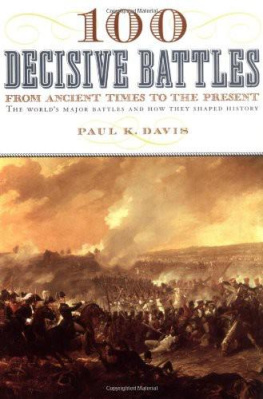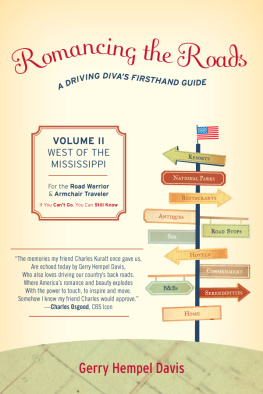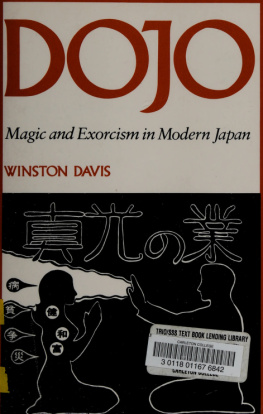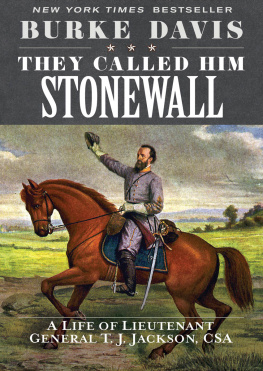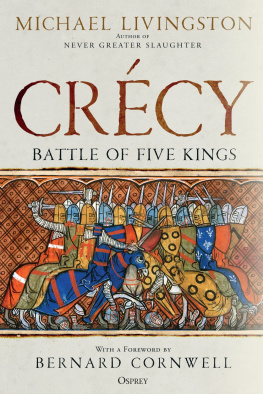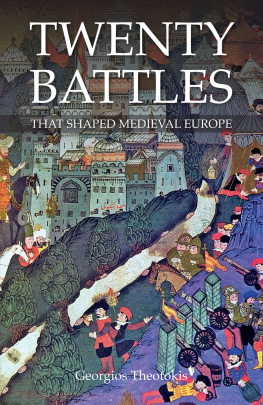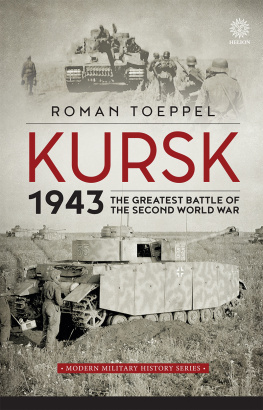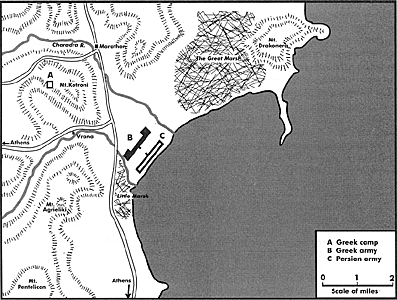Davis - 100 Decisive Battles: From Ancient Times to the Present
Here you can read online Davis - 100 Decisive Battles: From Ancient Times to the Present full text of the book (entire story) in english for free. Download pdf and epub, get meaning, cover and reviews about this ebook. City: USA;New York, year: 2001;1999, publisher: Oxford University Press, genre: History. Description of the work, (preface) as well as reviews are available. Best literature library LitArk.com created for fans of good reading and offers a wide selection of genres:
Romance novel
Science fiction
Adventure
Detective
Science
History
Home and family
Prose
Art
Politics
Computer
Non-fiction
Religion
Business
Children
Humor
Choose a favorite category and find really read worthwhile books. Enjoy immersion in the world of imagination, feel the emotions of the characters or learn something new for yourself, make an fascinating discovery.
100 Decisive Battles: From Ancient Times to the Present: summary, description and annotation
We offer to read an annotation, description, summary or preface (depends on what the author of the book "100 Decisive Battles: From Ancient Times to the Present" wrote himself). If you haven't found the necessary information about the book — write in the comments, we will try to find it.
From the ancient Egyptian battle at Megiddo in 1469 BC to the recent military actions in Iraq, great battles have had an enormous impact on the shaping of history. Now, in this fully illustrated book, one hundred of the worlds most important military confrontations are described in detail. 100 Decisive Battles gives us the facts about the battle and also explains where it fits in to the scope of world history.
In each entry we are given the name and date of the battle, the commanders, the size of the opposing forces, and casualties. An account of the battle plan and the military action are strategically discussed, and each description closes with a valuable consideration of how history was affected by the outcome of the conflict. Among the battles presented are the Battle of Thymbra (546 BC), the Battle of Chalons (451 AD), the Battle of Cajamarca (1532), the Battle of Dien Bien Phu (1954), and the Tet Offensive (1968). Accompanying maps and sidebars help further orient us with each military action.
Global in scope, with excellent coverage of American, Central American, European, Asian, and Middle Eastern battles, and with its stirring accounts of familiar battles and many lesser known military conflicts, 100 Decisive Battles is essential reading for military buffs and anyone interested in how the modern world came to be.
Amazon.com ReviewSometimes a battle, such as the one that raged along Frances Marne River in 1918, involves hundreds of thousands of soldiers and costs many lives. Sometimes, as in the case of Tippecanoe, a battle involves only a few hundred fighters. Great or small, as historian Paul Davis notes, history has turned on clashes such as these.
In this well-researched compendium, Davis examines battles that have had far-reaching historical consequences. The first entry covers the Battle of Megiddo, which delivered unto the Egyptian pharaoh Thutmose III an uneasy dominion over Palestine and broadened his empire into Asia; the final entry, set not far from the first, describes the Allied victory over Iraq in Desert Storm, which denied control of a large portion of the Middle East oil reserves to dictator Saddam Hussein and showed the ability of a multinational coalition to succeed in the post-Cold War world, perhaps setting an example of future international military action. In between Davis considers similarly fateful but often forgotten contests, such as the Battle of Chalons, when another coalition--this one of Visigoths, Romans, and Gallic and Germanic tribes--turned back the huge Mongol army of Attila in A.D. 451, and the Battle of Shanhaikuan, when, in the spring of 1644, Chinas Ming dynasty fell to Manchu invaders. Davis sometimes prefers sweeping themes to mundane realities (the fact, for instance, that the Battle of Adrianople turned on the recent invention of the stirrup), and his compendium tends heavily toward Europe at the expense of other parts of the world. The illustrations are also of uneven quality and usefulness.
Still, readers with an interest in military history will find this to be a handy reference and overview, and theyll enjoy second-guessing the author, nominating battles that didnt make his hundred while learning from the obscure, but nonetheless critical, ones that he does address. --Gregory McNamee
From BooklistWhenever anyone makes the definitive list on a subject, their choices are going to be second-guessed. Davis acknowledges the likelihood of continued debate regarding his selections in his preface. For example, why was Singapore included in the World War II section but not El-Alamien, why Leuctra and not Cannae, and so forth. For this list, his criteria included major social or political change resulting from the battles outcome and major changes in warfare. He also states that he drew extensively upon the expertise of members of H-WAR, an Internet news group of military historians, in deciding which battles to include.
Entries begin in 1479 B.C. with Megiddo and end in 1991 with Desert Storm. There are familiar battles (Gettysburg, Marathon, Spanish Armada) and lesser known, such as Leuctra (371 B.C.), which ended Spartan dominance of the Greek peninsula. Non-European battles include Tsushima (1905), which established Japan as a naval force in their victory over Russia, and Huai Hai (Suchow) (1948^-1949), which ultimately led to the establishment of Taiwan.
Each entry is about three pages long and begins with facts regarding the sides involved and the number of forces engaged and a one-paragraph statement of the battles importance. This is followed by historical background, description of the battle, and an analysis of the results. There are maps for some but not all of the battles. Supplemental information, such as a discussion of the Monroe Doctrine, is highlighted in sidebars. References are included at the end of each article as well as in the 100-page bibliography. Books are the primary sources listed, with a few magazine articles included.
This title provides broader coverage than John Macdonalds Great Battlefields of the World (Macmillan, 1985), which discusses only 30 battles; and it complements the more comprehensive Dictionary of Wars [RBB N 15 99]. It is a good specialized resource for world military history that could be used by high-school students as well as military-history buffs. Recommended for high-school, public-library, and undergraduate collections.
Copyright American Library Association. All rights reserved
Davis: author's other books
Who wrote 100 Decisive Battles: From Ancient Times to the Present? Find out the surname, the name of the author of the book and a list of all author's works by series.

